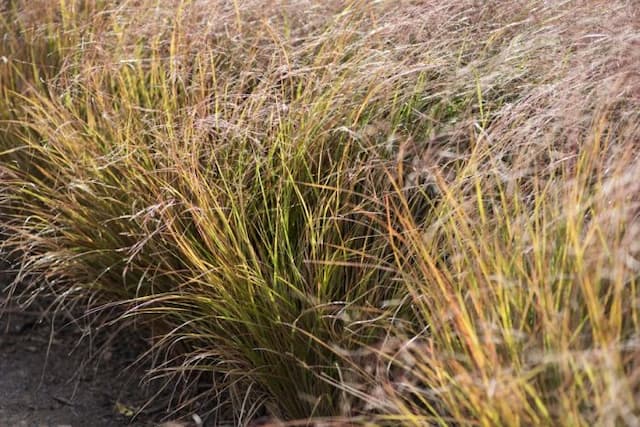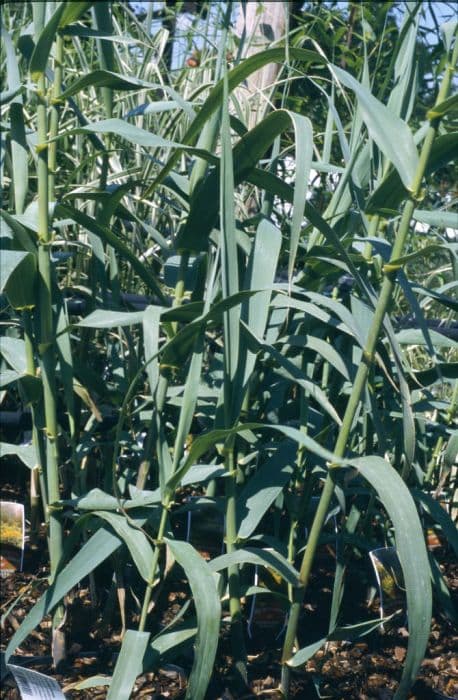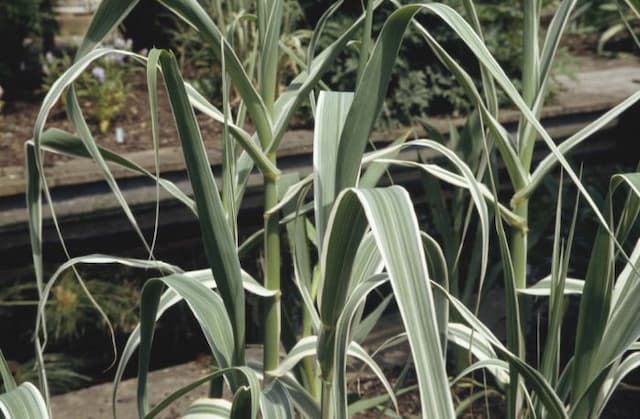Autumn Moor Grass Sesleria autumnalis

ABOUT
Sesleria autumnalis, commonly known as autumn moor grass, is a perennial plant that boasts a clumping, tufted growth habit. The appearance of this grass is characterized by its dense, mounding tufts of narrow, linear leaves. These leaves are typically a bluish-green hue that can add a cool-toned accent to any landscape setting. The plant is notable for its two-toned foliage, which may display darker green on top and a lighter, silvery underside, giving a multi-dimensional and textured effect. In the spring, the foliage may also have a distinctive, silver-gray color that shines in the garden. In addition to its attractive foliage, autumn moor grass produces flowering stalks which bear a striking resemblance to spikes. These flower spikes, emerging above the foliage, transition through a palette of colors as they age. They start as a pale green or silver shade and gradually turn to a golden-brown or tan color, furnishing the plant with an enduring visual appeal that lasts into the fall. The airy flower spikes can sometimes give the plant a soft, hazy appearance, and when they catch the light or sway in a breeze, they contribute to a dynamic and naturalistic garden aesthetic. Autumn moor grass's visual charm, along with its dense and tidy form, makes it a versatile and appealing choice for gardens and landscapes, providing year-round interest.
About this plant
 Names
NamesFamily
Poaceae
Synonyms
Autumn Moor Grass
Common names
Sesleria autumnalis.
 Toxicity
ToxicityTo humans
Autumn moor grass is not known to be toxic to humans. There are no well-documented symptoms of poisoning from ingestion of this plant, indicating it is generally considered safe. However, it is important to note that even non-toxic plants can sometimes cause mild stomach upset or allergic reactions in sensitive individuals if ingested. Therefore, it is always wise to avoid eating plants not specifically grown for consumption.
To pets
Autumn moor grass is not known to be toxic to pets either. It is not associated with any specific symptoms of poisoning in animals such as dogs or cats. Just like in humans, ingestion may occasionally cause mild gastrointestinal upset, but serious toxicity is not expected. As with humans, caution should be exercised, as animals can have individual sensitivities to plants that are typically considered non-toxic.
 Characteristics
CharacteristicsLife cycle
Perennials
Foliage type
Evergreen
Color of leaves
Green
Flower color
Varies
Height
1-2 feet (30-60 cm)
Spread
1-2 feet (30-60 cm)
Plant type
Herb
Hardiness zones
4
Native area
Europe
Benefits
 General Benefits
General Benefits- O ornamental appeal: Sesleria autumnalis, commonly known as Autumn Moor Grass, has a graceful clumping habit and fine-textured green foliage that turns into a golden hue in autumn, adding aesthetic value to gardens and landscapes.
- Drought tolerance: Once established, Autumn Moor Grass is relatively drought-resistant, which makes it suitable for xeriscaping and gardens in drier climates.
- Low maintenance: This plant generally requires minimal care beyond occasional watering in extremely dry conditions and cutting back old foliage before new growth in spring.
- Erosion control: The dense growth habit of Autumn Moor Grass helps stabilize soil and control erosion, especially on slopes or in areas prone to soil degradation.
- Provides habitat: It offers shelter and habitat for various small wildlife and insects, contributing to biodiversity in the garden.
- Seasonal interest: With its late-blooming flowers that persist into winter, Autumn Moor Grass offers visual interest across multiple seasons.
- Versatility in landscaping: It can be planted in a variety of settings ranging from formal borders to naturalistic meadows, making it a versatile choice for a range of garden designs.
- Tolerant of a variety of soils: Autumn Moor Grass can thrive in a range of soil types, including clay, making it a good choice for challenging garden sites.
- Works well in mass planting: Due to its clump-forming nature, it works effectively when planted in large groups, creating a uniform look that is particularly striking.
 Medical Properties
Medical PropertiesThis plant is not used for medical purposes.
 Air-purifying Qualities
Air-purifying QualitiesThis plant is not specifically known for air purifying qualities.
 Other Uses
Other Uses- Sesleria autumnalis, also known as Autumn Moor Grass, is sometimes used for roof thatching in traditional construction practices, providing a durable and weather-resistant roof covering.
- As a dense, clump-forming grass, Autumn Moor Grass is suitable for ground stabilization and erosion control on sloped landscapes and embankments.
- The fibrous nature of Autumn Moor Grass makes it suitable for crafting biodegradable garden pots, which can decompose and enrich the soil after planting.
- The plant can be utilized in landscape design as a textural contrast to broad-leaved plants, offering an aesthetic balance in gardens and parks.
- The dried inflorescences of Autumn Moor Grass are sometimes used in floral arrangements and dried bouquets for their unique structure and lasting quality.
- Its ability to thrive in poor soils makes Autumn Moor Grass an ideal candidate for reclaiming and vegetating disturbed sites such as old mines or quarries.
- Some artisans may use the leaves and stalks of Autumn Moor Grass for papermaking, creating a distinctive, textured handmade paper.
- Autumn Moor Grass can act as a living mulch, its dense growth suppressing weeds and reducing garden maintenance requirements.
- In winter months, Autumn Moor Grass provides valuable habitat and cover for small wildlife, insects, and ground-nesting birds.
- Due to its uniform growth habit, Autumn Moor Grass is often used in modern garden design to create a sense of calm uniformity and minimalist aesthetics.
Interesting Facts
 Feng Shui
Feng ShuiAutumn moor grass is not used in Feng Shui practice.
 Zodiac Sign Compitability
Zodiac Sign CompitabilityAutumn moor grass is not used in astrology practice.
 Plant Symbolism
Plant Symbolism- Autumn Moorfest (Common name): This plant symbolizes the end of summer and the beginning of autumn, marking a transition period in nature where growth slows down and prepares for the winter.
- Resilience: Sesleria autumnalis can thrive in challenging conditions and often symbolizes the ability to endure and persist through tough times.
- Adaptability: Its capacity to adapt to various environmental conditions makes it a symbol of versatility and flexibility in life.
- Balance: The plant's growth habits reflect a balance between vigor and restraint, symbolizing the importance of equilibrium in our lives.
- Subtlety: The plant's discreet flowers and foliage represent understated beauty, suggesting qualities of modesty and elegance without the need for ostentation.
 Water
WaterFor the Autumn Moor Grass, it is best to provide consistent moisture, especially during active growth in spring and fall. Water the plant deeply once a week, supplying about 1 to 1.5 inches of water each time, which is roughly equivalent to 0.6 to 0.9 gallons for a standard garden area. During hot, dry periods, you may need to water twice a week, while in cooler, wetter conditions, you can reduce watering frequency. Allow the top inch of soil to dry out between waterings to prevent root rot. Overwatering can be as detrimental as underwatering, so adjust your schedule according to weather conditions and soil moisture levels.
 Light
LightAutumn Moor Grass thrives best in full sun to partial shade. It should be placed in a location where it will receive at least six hours of sunlight daily, but it can also tolerate some light dappled shade, especially in hotter climates. Avoid deep shade as it can lead to sparser growth and reduced vigor.
 Temperature
TemperatureAutumn Moor Grass prefers moderate temperatures and can handle a range from around 20°F to 90°F. However, ideal growth occurs when temperatures are between 50°F and 75°F. It is cold tolerant and can survive brief periods of colder temperatures, but prolonged exposure to temperatures below 20°F may damage the plant.
 Pruning
PruningPruning Autumn Moor Grass is done mainly to tidy the plant and encourage new growth. Trim back the dead foliage in early spring before new growth starts. This annual pruning should be done carefully, cutting the plant back by about a third to maintain its shape and size. The best time for pruning is when the threat of severe frost has passed.
 Cleaning
CleaningAs needed
 Soil
SoilAutumn Moor Grass prefers well-drained soil with a slight acidity to neutral pH, ranging from 5.5 to 7.0. The best soil mix should contain loamy or sandy compost with adequate organic matter to retain moisture without becoming waterlogged. Adding perlite or sand can improve drainage.
 Repotting
RepottingAutumn Moor Grass does not frequently require repotting as it is a hardy perennial. Repotting every 3-4 years or when it outgrows its container is usually sufficient to maintain its health.
 Humidity & Misting
Humidity & MistingAutumn Moor Grass tolerates a wide range of humidity conditions and does not require high humidity to thrive. It is generally content with the natural outdoor humidity levels found in its growing zones.
 Suitable locations
Suitable locationsIndoor
Place Autumn Moor Grass near a bright window in well-draining soil.
Outdoor
Plant Autumn Moor Grass in full sun to part shade in loamy soil.
Hardiness zone
4-9 USDA
 Life cycle
Life cycleSesleria autumnalis, commonly known as Autumn Moor Grass, begins its life cycle as a seed, typically germinating in the spring when soil temperatures are favorable. The seedlings emerge from the soil and establish a root system, after which the plant begins to grow vertically, developing a tuft of narrow, green leaves. As the plant matures through the growing season, it forms dense clumps and prepares to reproduce. By late summer or early autumn, it produces flowering stalks that bear small, inconspicuous flowers which are wind-pollinated. Following pollination, seeds are produced and dispersed, either by wind or animals, completing the reproductive phase. Over winter, the grass may remain evergreen or semi-evergreen, depending on local climate conditions, and the cycle repeats with new seed germination the subsequent spring.
 Propogation
PropogationPropogation time
Spring to early summer
The most popular method for propagating Sesleria autumnalis, commonly known as Autumn Moor Grass, is through division. This process is best done in the spring as the grass begins to grow actively. To propagate by division, carefully dig up an established clump of Autumn Moor Grass and gently separate the plant into smaller sections, ensuring that each new section has a healthy portion of roots attached. These divisions should then be immediately replanted at the same soil depth they were previously growing at and watered thoroughly. The new plants will establish roots and start growing, gradually maturing into separate clumps Iike the parent plant. It's important to keep the soil moist but not soggy until the new grasses are well established.









